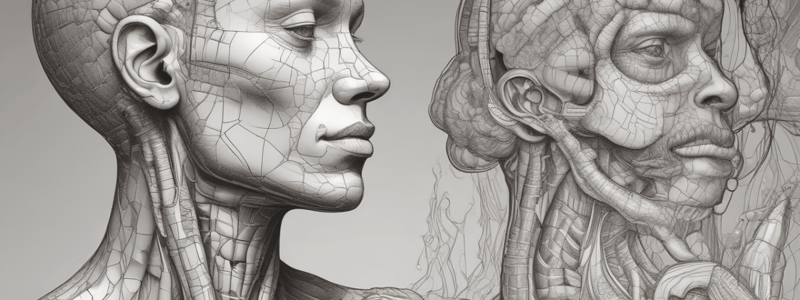Podcast
Questions and Answers
What is the primary function of the epidermis?
What is the primary function of the epidermis?
- To act as a barrier against external factors (correct)
- To produce hair and sweat
- To regulate body temperature
- To provide nerve endings and sensation
Which of the following is NOT a characteristic of the dermis?
Which of the following is NOT a characteristic of the dermis?
- It contains blood vessels and nerves
- It contains dense connective tissue
- It is the outermost layer of the skin (correct)
- It contains sebaceous glands and hair follicles
What is the name of the lines that appear on the skin due to aging and repeated muscle contraction?
What is the name of the lines that appear on the skin due to aging and repeated muscle contraction?
- Langer's lines (correct)
- Fascia lines
- Skin creases
- Wrinkles
What is the main function of sweat glands in the skin?
What is the main function of sweat glands in the skin?
What is the term for the study of the structure and function of the skin?
What is the term for the study of the structure and function of the skin?
What is the term for the thin, translucent layer of skin that is found in areas such as the eyelids and genitalia?
What is the term for the thin, translucent layer of skin that is found in areas such as the eyelids and genitalia?
What is the function of sebaceous glands in the skin?
What is the function of sebaceous glands in the skin?
What is the term for the strong, fibrous tissue that surrounds and supports muscles and other organs?
What is the term for the strong, fibrous tissue that surrounds and supports muscles and other organs?
What is the main function of the skin in terms of body physiology?
What is the main function of the skin in terms of body physiology?
What is the term for the thick, keratinized plates found on the dorsal surface of fingers and toes?
What is the term for the thick, keratinized plates found on the dorsal surface of fingers and toes?
What is a characteristic of deep fascia in the limbs?
What is a characteristic of deep fascia in the limbs?
What is a function of deep fascia in the neck?
What is a function of deep fascia in the neck?
What is a function of deep fascia in the muscles?
What is a function of deep fascia in the muscles?
What is a characteristic of deep fascia in the face?
What is a characteristic of deep fascia in the face?
What is a function of deep fascia in the joints?
What is a function of deep fascia in the joints?
What is a function of deep fascia in the flexor surface of fingers?
What is a function of deep fascia in the flexor surface of fingers?
What is a function of deep fascia in the body?
What is a function of deep fascia in the body?
What is a characteristic of deep fascia in the thorax and abdomen?
What is a characteristic of deep fascia in the thorax and abdomen?
What is the primary function of the sebaceous glands in the skin?
What is the primary function of the sebaceous glands in the skin?
What is characteristic of skin creases at joints?
What is characteristic of skin creases at joints?
What is the orientation of Langer lines in the trunk?
What is the orientation of Langer lines in the trunk?
What is the characteristic of superficial fascia in the scalp?
What is the characteristic of superficial fascia in the scalp?
What is the function of superficial fascia in facilitating movements of the skin?
What is the function of superficial fascia in facilitating movements of the skin?
What is characteristic of superficial fascia in the eye lids and auricle of the ear?
What is characteristic of superficial fascia in the eye lids and auricle of the ear?
What is the function of superficial fascia in giving the body its shape?
What is the function of superficial fascia in giving the body its shape?
What is characteristic of deep fascia?
What is characteristic of deep fascia?
What is the function of deep fascia in relation to muscles?
What is the function of deep fascia in relation to muscles?
What is the relationship between skin creases and Langer lines?
What is the relationship between skin creases and Langer lines?
What is the primary function of the skin in regards to thermoregulation?
What is the primary function of the skin in regards to thermoregulation?
What is the function of superficial fascia?
What is the function of superficial fascia?
What is the consequence of vitamin D deficiency in infants?
What is the consequence of vitamin D deficiency in infants?
What is the function of the skin in regards to expression?
What is the function of the skin in regards to expression?
What is the characteristic of the skin in the palm and hand?
What is the characteristic of the skin in the palm and hand?
What is the primary function of deep fascia?
What is the primary function of deep fascia?
What is the purpose of Sweat glands in the skin?
What is the purpose of Sweat glands in the skin?
What is the function of skin in regards to water and electrolytes?
What is the function of skin in regards to water and electrolytes?
Flashcards are hidden until you start studying
Study Notes
Skin Definition and Features
- Skin is the largest organ in the body
- Divided into two layers: epidermis (superficial) and dermis (deep)
- Epidermis is thick in the palm and sole
- Dermis is made of dense connective tissue containing blood vessels, nerves, and lymphatics
- Dermis also contains sweat glands, sebaceous glands, and hair follicles
Skin Appendages
- Nails: keratinized plates on the dorsal surface of fingers and toes
- Hair follicles
- Sweat glands: deepest structure in the dermis
- Sebaceous glands: present in the dermis and secrete sebum
Skin Lines
- Skin creases: grooves opposite joints, where skin is thin and firmly adherent to underlying structures
- Langer's lines (or cleavage lines): correspond to the natural orientation of collagen in the dermis
- Incisions made parallel to Langer's lines heal better than those made across the lines
Fascia
- A layer that lies beneath the skin
- Divided into two layers: superficial fascia and deep fascia
Superficial Fascia
- A layer of loose connective tissue containing fat
- Firmly attached to the skin in the scalp, back of the neck, palm, and sole
- Loosely attached to the skin in the dorsum of the hand and foot
- Devoid of fat in the eyelids, auricle of the ear, penis, scrotum, and clitoris
- Rich in fat in the breast and gluteal region
- Functions:
- Facilitates movements of the skin
- Bad conductor of heat
- Gives the body its shape
- Contains blood vessels, nerves, and sometimes muscles
- Holds skin firmly to deeper structures by bundles of collagen
Deep Fascia
- A membranous layer of connective tissue that invests muscles
- Well developed in limbs, thin in thorax and abdomen, and absent in most of the face
- Functions:
- Covers the muscles and assists in their action
- Deep surface of fascia gives rise to septa and is thickened in the palm and sole forming palmer and planter aponeuroses
- Thickened around joints forming retinacula and fibrous flexor sheaths
- Helps in venous return
Physiology of Skin
- Functions:
- Protection against physical and chemical trauma, microorganisms, and radiations
- Thermoregulation through negative feedback between skin, skeletal muscles, sweat glands, and hypothalamus
- Sensation through high number of sensory receptors in the skin, especially in the face and fingertips
- Water storage and protection of normal water and electrolyte levels
- Absorption of drugs and toxic organisms
- Expression of emotions, behavior, and communication through facial expressions
- Synthesis of vitamin D
Studying That Suits You
Use AI to generate personalized quizzes and flashcards to suit your learning preferences.




